Abbott Opens Food Courts, Water Parks Under Phase II
More restrictions are being relaxed as new cases of the novel coronavirus continue to drop locally, and more people are out and about because of that. We have your bullet points for the day:
- Abbott opens food courts and water parks under Phase II;
- New cases, hospitalizations remain flat;
- What we flush could help predict COVID-19 surges, a new study suggests;
- School’s out (for real), and students can get free lunch.
Abbott Opens Food Courts, Water Parks Under Phase II
 If you’ve got a hankering for a pretzel or want to float down an artificial lazy river, you’re in luck – Gov. Greg Abbott issued a proclamation Tuesday opening water parks, recreational sport programs for adults, driver education programs, and mall food-courts beginning this week.
If you’ve got a hankering for a pretzel or want to float down an artificial lazy river, you’re in luck – Gov. Greg Abbott issued a proclamation Tuesday opening water parks, recreational sport programs for adults, driver education programs, and mall food-courts beginning this week.
Water parks may open at 25% occupancy starting Friday, and any video arcades within the parks must remain closed. Recreational sport programs for adults can begin on May 31, but games and competitions can’t happen until June 15. Driver education programs can start immediately, too.
Food courts can open immediately, “but malls are encouraged to designate one or more individuals who are responsible for ensuring health and safety practices are followed,” Abbott’s announcement said. Those practices include limiting tables to six people, maintaining a 6-feet distance between individuals sitting at different tables, cleaning and disinfecting tables between uses, and ensuring that condiments and other debris aren’t left on tables between customers.
While Six Flags Hurricane Harbor hasn’t announced when it will reopen, it did say it would be requiring reservations to enter the park when it did.
New Cases, Hospitalizations Remain Flat
Dallas County health officials reported 190 new cases of COVID-19 Tuesday, bringing the total case count for the county to 9,188, including 213 total deaths.
The county also reported two additional deaths, a Garland man in his 60s who died at an area hospital emergency room, and a man in his 70s who was a resident of a Mesquite long-term care facility. Both had underlying health conditions.
Of the 213 total deaths reported to date, over a third have been associated with long-term care facilities.
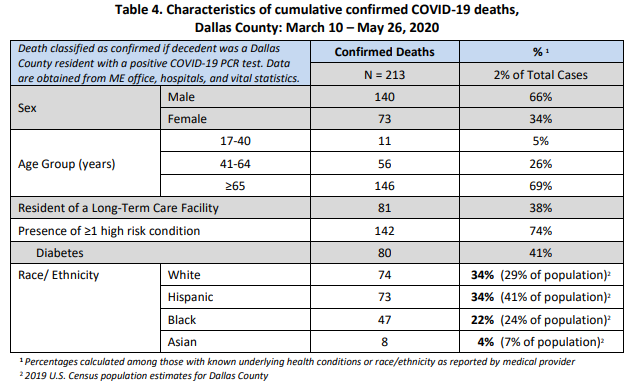
“The indicators the public health committee is using to determine our threat level on the color-coded chart are hospitalizations, ER visits for COVID-19 and ICU admissions for COVID-19,” Dallas County Judge Clay Jenkins said. “They remain flat. In order to move to a lower threat level, the doctors tell me we need to see a 14-day decline in those three factors which unfortunately have yet to materialize. I’m hopeful that with the modest decline in cases we’ve seen over the last 2 weeks, we will begin that decline in hospitalizations, ICU admissions and ER visits soon.”
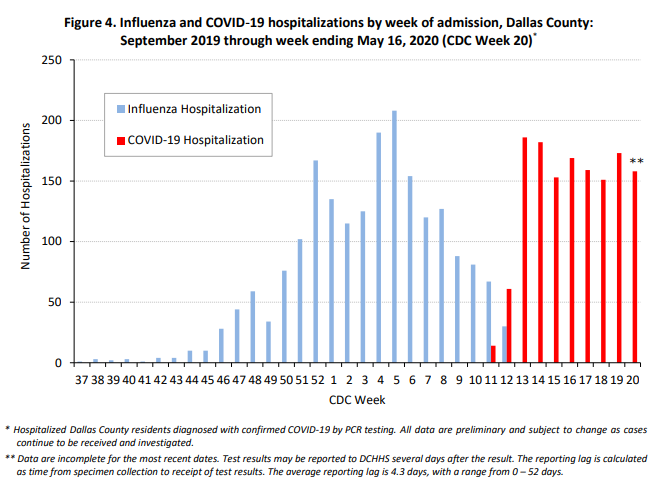
Jenkins reiterated that the longevity of the decline depended on how well everyone abided by social distancing practices.

Tuesday afternoon, Dallas Mayor Eric Johnson said that 25 hospitals reported their bed availability. Of the 6,049 total beds, 61% are occupied. A week ago, we reported that of 5,713 total beds, 65% were occupied.
Of the 885 ICU beds available, 66% are occupied – Monday, there were 885 available, with 71% of them occupied. And 328 of the total 986 ventilators available were in use as of Tuesday.
 Of cases requiring hospitalization who reported employment, about 83% have been critical infrastructure workers including those in healthcare (14%), transportation (14%), food and agriculture – which includes grocery stores and places you can buy food (15%), public works (13%), finance (4%), communications (2%), teachers, real estate, and clergy (6%), and first responders (3%).
Of cases requiring hospitalization who reported employment, about 83% have been critical infrastructure workers including those in healthcare (14%), transportation (14%), food and agriculture – which includes grocery stores and places you can buy food (15%), public works (13%), finance (4%), communications (2%), teachers, real estate, and clergy (6%), and first responders (3%).
In the county’s May 26 aggregate report, most cases continue to be between the ages of 18 and 60, with the 18-40 age group accounting for 40% of the cases, and the 41-64 age group accounting for another 40% of the total cases.
Close contact or community transmission continues to be the biggest risk factor for contracting COVID-19, accounting for roughly 86.3% of all cases. Living in a long-term care facility, being incarcerated in the county jail, and working in a meat or food processing plant are a distant second, third, and fourth, at 4.6%, 3.9%, and 2.3%, respectively. Domestic travel has dropped to 1.4%.
Of the testing done, positive cases accounted for 9.7% of tests at local hospitals as of May 16, down from 11.6% as of May 9, with 502 positives coming from 5,182 tests. Testing and positive test results of COVID-19 far outpaces any other respiratory virus – even if you combine them all.
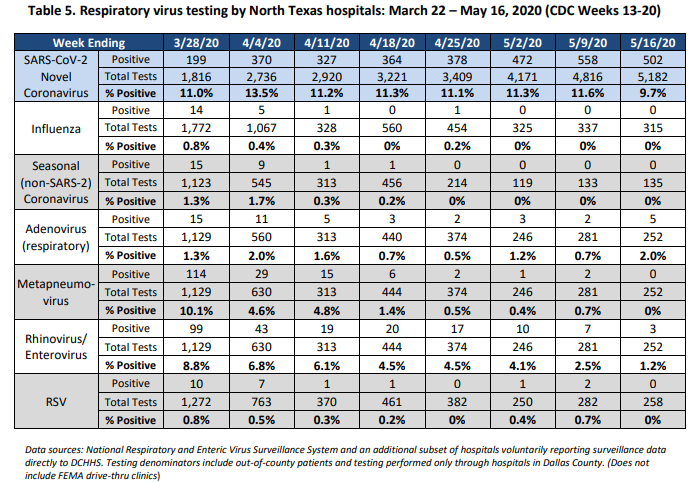
It’s also worth noting that there seems to be a bit of a lag. Last week, when we reported the May 9 numbers, 10.9% of the 4,151 tests came back positive. That number changed, as you can see above, by the time the aggregate report for May 22 came out. Since May 2 showed an 11.3% positive rate, over time, it appears that the percentage of positive tests performed at local hospitals has remained fairly flat.
Hospitalizations because of COVID-19 have also eclipsed influenza hospitalizations on a weekly basis, too, and have for some time. ICU admissions and deaths already have eclipsed flu numbers.
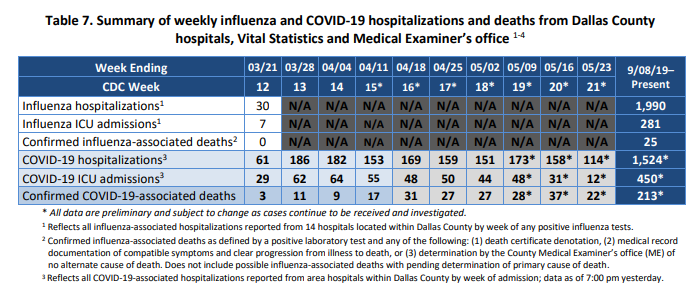
Seventeen percent of all cases ended up hospitalized – 30% ended up in intensive care, and 18% ended up on a ventilator.
In a city-by-city breakdown, Dallas still comes in with the highest number of cases – 5,116, or 55.7%. Highland Park has 18 cases so far, and University Park has 26.
The county does not count recoveries because it’s not a variable being used nationally by the Centers for Disease Control and Prevention, nor by state health departments. However, one can extrapolate that the 83% of total cases that have not been hospitalized – at the very least – are on their way to recovery or have recovered, county officials explained recently.
“The exact number of patients who have been released from area hospitals to continue their recovery at home is not available at this time,” Lauren Trimble, Dallas County Judge Clay Jenkins’ chief of staff, said.
Statewide, 821,233 tests have been administered, with 56,560 testing positive in 229 counties, and 1,536 deaths so far.
What We Flush Could Help Predict COVID-19 Surges, New Study Suggests
In our never-ending quest to bring you the latest studies regarding the global coronavirus pandemic, today’s new data point comes straight from the toilet.
A new study from Yale skipped swabs and serum tests and went straight to raw sewage to test concentrations of COVID-19 RNA in sewage sludge.
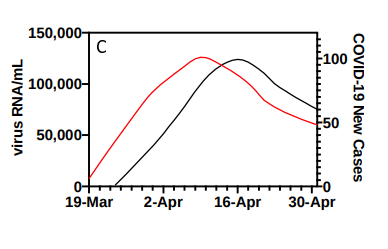
“SARS-CoV-2 RNA concentrations were a seven-day leading indicator ahead of compiled COVID-19 testing data and led local hospital admissions data by three days,” the report read. “Decisions to implement or relax public health measures and restrictions require timely information on outbreak dynamics in a community.”
What does that mean? It means that, in layman’s terms, the presence of novel coronavirus RNA not only could track a surge, it was a few days ahead of hospital admissions data – meaning that by tracking sewage, potentially, hospitals could be better prepared for potential surges.
The study has not been printed in any journals yet, nor has it been subject to peer-review (yet), but others have also talked about the presence of virus RNA in sewage as well.
School’s Out (For Real), and Students Can Get Free Lunch
 No more pencils, no more books, no more … well, to be more accurate, no more Zooming, no more Google Classroom, no more Class Dojo messages asking if you read that book.
No more pencils, no more books, no more … well, to be more accurate, no more Zooming, no more Google Classroom, no more Class Dojo messages asking if you read that book.
The last day of school for nearly every child in Dallas is today, and Taco Cabana is offering the youngest students a free lunch every day through the end of summer.
The lunch, which includes a bean and cheese taco, chips and queso, and a drink, is available to kids 12 and younger every weekday from 11 a.m. to noon.
The company said it was driven to offer free lunches because the novel coronavirus pandemic has left many children without a reliable source of food this summer.
“We have been part of this community for more than 40 years, and Texas has been hit hard during these unprecedented times. We are happy to offer kids in our communities a free meal they love,” said Patricia Lopez-Calleja, senior vice president of guest engagement for Fiesta Restaurant Group, parent company of Taco Cabana. “We hope we can provide some needed relief to the many families that have been impacted by the current health crisis.”
Children must be present and accompanied by a parent or guardian, and the meals are available at the drive-throughs only.









